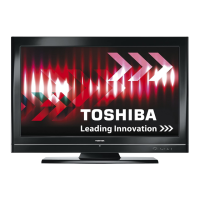
Do you have a question about the Toshiba 40BV700B and is the answer not in the manual?
| Audio system | NICAM Stereo |
|---|---|
| RMS rated power | 16 W |
| Number of speakers | 2 |
| Comb filter | 3D |
| Response time | 8 ms |
| Display diagonal | 40 \ |
| Progressive scan | Yes |
| Display brightness | 450 cd/m² |
| Display technology | LCD |
| Native aspect ratio | 16:9 |
| Native refresh rate | 50 Hz |
| Contrast ratio (dynamic) | 40000:1 |
| Game mode | No |
| RS-232 ports | 0 |
| Audio (L/R) out | 1 |
| HDMI ports quantity | 4 |
| USB 2.0 ports quantity | USB 2.0 ports have a data transmission speed of 480 Mbps, and are backwards compatible with USB 1.1 ports. You can connect all kinds of peripheral devices to them. |
| Headphone connectivity | 3.5 mm |
| Product color | Black |
| Power consumption (standby) | 0.9 W |
| Power consumption (typical) | 138.74 W |
| Depth (with stand) | 219 mm |
|---|---|
| Height (with stand) | 653 mm |
| Weight (with stand) | 15100 g |
| Depth (without stand) | 99 mm |
| Height (without stand) | 613 mm |
| Weight (without stand) | 14400 g |
Guidelines for ventilation and avoiding heat damage to the television.
Ensuring correct mains connection and general safety warnings.
Key 'Do' and 'Do Not' instructions for safe and proper use of the equipment.
Advice on TV placement, stability, and careful screen handling.
Toshiba's liability exclusions and important notes regarding TV usage.
Information about the UK's transition to digital TV broadcasting and its impact.
Step-by-step guide on how to re-tune the TV for new digital channels.
Guide to remote functions, battery installation, and optimal operating range.
Instructions for connecting aerials, SCART, and other external audio/video sources.
How to connect HDMI/DVI devices and computers to the TV's HDMI input.
Connecting USB devices for media playback, file system support, and usage cautions.
Information on energy efficiency, power save modes, and environmental considerations.
Instructions on how to use the provided cable holder for organizing cables.
How to turn the TV on/off, use standby, and implement energy-saving practices.
Guide to operating the TV using its side buttons and the remote control.
Selecting channels, stereo/bilingual audio, volume adjustment, and input selection.
Accessing and navigating the TV's main menu and options.
Viewing channel lists, info banners, and using the Electronic Programme Guide (EPG).
How to search for programmes and display digital subtitles.
Using PIP/PAP modes and accessing the TV's configuration menu for settings.
Customizing sound (Equalizer, AVL) and picture (Mode, Brightness, Colour) settings.
Picture Zoom, Resetting Picture Settings, Child Lock, and other system controls.
Settings for menu display, input selection, TXT language, and programme timers.
Using the Common Interface slot and the Media Browser for USB devices.
Connecting USB devices, browsing media, playing MP3 and JPG files.
Using slideshow, video playback controls, and exiting the media player application.
Details broadcast systems, video input, display, sound, power, dimensions, and operating conditions.
List of external connection ports and included accessories.
Information on screen cleaning, product/battery disposal, and licensing details.